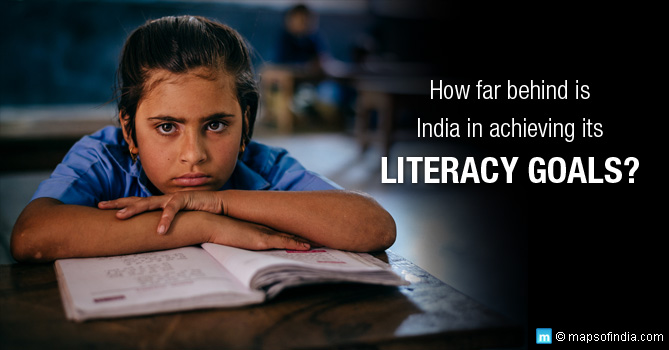In simple words – getting education is the fundamental human right of every individual irrespective of gender. But some people in our society do not understand this and make such a simple thing extremely complicated. We must be aware of the fact that if she is uneducated then close to half of the population is uneducated. Educating a woman means educating the family and the nation.
‘Education for all’ is one of the major tasks being carried out by the Indian government but still we have the lowest female literacy rate in Asia. India is working but the pace is slow as we haven’t achieved what we should have been so far. At the start of British Raj till independence just 2-6% of females were literate. The percentage went up to 15.3% in 1961 and 28.5% in 1981. Literacy rate crossed 50% in 2001. By 2011 female literacy rate in India stood at 65.46%. So there is an obvious increase in the female literacy rate but India is far behind as compared to other countries at global level. Female illiteracy rate varies with the state. In Kerala 86% of women are literate whereas literacy rate in Bihar and Uttar Pradesh is just between 55-60%. Shockingly the rural areas of India have the lowest female literacy rate. Rural Rajasthan has less than 12% female literacy rate.
Sex based discrimination is prevalent in India. Thus you must have seen or heard that many parents especially in lower strata of society send their male child to school but not the girl child. This is one problem where parents do not send their daughters to school. Secondly, it is also common to see that parents especially in urban areas often send their male child to better schools. Even if girls are enrolled, their dropout rate is very high. Why girls are treated in this manner?
We must understand the consequences of not educating our girl child. When a woman is not educated then it not only affects her but the entire family as well as the nation. In many studies it has been found out that illiterate women have high fertility as well as mortality rate. It has been seen that infant mortality rate reduces to half in case women have received primary education as compared to illiterate female. Apart from this children, of illiterate woman are malnourished. Illiteracy also reduces the overall earning potential of the family.
Women must be educated for a healthy and a happy life. An educated woman can be a better human being, successful mother and a responsible citizen. Educating women will definitely increase the living standard both at and outside home. An educated woman will force her kids to study further and wish them to live a better life than hers.
Educating women results in promoting self respect and also helps in raising the status of women. An educated woman will be aware of her rights. She can fight against social evils such as domestic violence, dowry demand, low wages etc.
Historical background
The East India Company’s Programme ‘Wood’s Dispatch’ recognized the employment and education of women in India in 1854. Initially only the richer sections of the society and primary level of education were focused under this programme. With the help of this, female literacy rate in India raised from 0.2% in 1882 to 6% in 1947.
After independence, the University Education Commission was created with an aim to improve the quality of education through suggestions. But it was against female education and considered educating women irrelevant. (I must say that it forgot that managing home is a full time job in itself and needs mind). The commission regarded female education as the waste of time. However number of educated females were increasing in number and created a need of a body to work towards this. Therefore, in 1958 government appointed a national committee on women’s education. In one of its recommendations it said that female education must be brought to the level of boys’ education. Such talks resulted in many such committees and ultimately led to the formation of the Education Commission in 1964.
Though many steps have been taken so far to improve the education level of women in India but the 86th Constitutional Amendment Act, 2002 has been a commendable step in this regard. Under this act elementary education was made free and compulsory for the children belonging to the age group of 6-14 years. This initiated Sarva Shiksha Abhiyan (SSA). SSA is the main programme to achieve Universalization of Elementary Education (UEE) in a time bound manner.
Welfare schemes for women
Mahila Samakhya Programme: New Education policy of 1968 led to the launch of Mahila Samakhya Programme in 1988 for the empowerment of rural women belonging to socio-economical weaker section.
Kasturba Gandhi Balika Vidyalaya Scheme(KGBV): Girls are educated to primary level through KGBV. It basically works in rural areas where female literacy is low.
National Programme for Education of Girls at Elementary Level (NPEGEL): Girls who are not incentivized through SSA are covered by NPEGEL.
Saakshar Bharat Mission for Female Literacy: This mission was launched with an objective to bring down the female illiteracy.
Apart from this there are midday meal schemes, free distribution of uniforms and books for girls. But still we have to work towards many issues such as infrastructure, teacher is to student ratio, safety of female children at school, better curriculum, sanitation facilities so that more and more girls can be educated. Moreover parents must understand the importance of education and must not differentiate their male and female child. We must understand that an educated woman is able to play all her roles with greater responsibility than uneducated one.
Related Information :
International Literacy Day 2016: How far behind is India in achieving its Literacy Goals
Mission Mangalam for women empowerment
Will the Status of Women Ever Change?




